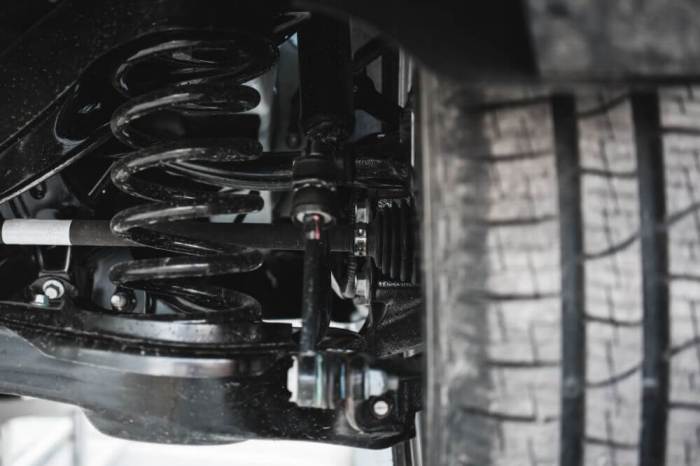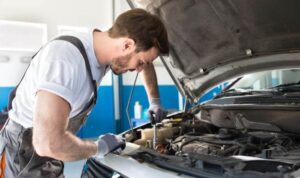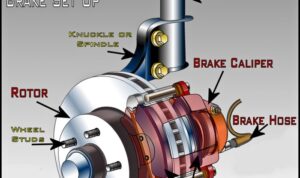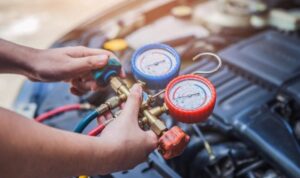How to fix car suspension issues starts with understanding the crucial role of the suspension system in your vehicle, followed by diagnosing common problems and providing solutions to keep your ride smooth and safe.
In this guide, we’ll explore the ins and outs of car suspension maintenance to help you tackle any issues that may arise.
Understanding Car Suspension

Car suspension plays a crucial role in ensuring a smooth and comfortable ride for passengers while also maintaining stability and control of the vehicle. It consists of various components that work together to absorb shocks from the road surface and provide support to the vehicle.
When your car’s air conditioning system is not functioning properly, it can be a frustrating experience, especially during hot summer days. If you are wondering how to troubleshoot car AC issues, there are a few common problems you can check for.
Start by checking the refrigerant levels, inspecting the compressor, and ensuring the condenser is clean and free of debris. For more detailed steps on diagnosing and fixing car AC problems, you can refer to this helpful guide on How to troubleshoot car AC issues.
Role of the Suspension System
- The suspension system helps to keep the tires in contact with the road surface, ensuring optimal traction and stability.
- It absorbs shocks and vibrations from the road, preventing them from being transferred to the vehicle’s body and passengers.
- By maintaining a consistent ride height, the suspension system helps to prevent bottoming out and maintains proper alignment of the wheels.
Common Signs of Suspension Issues
- Uneven tire wear, which can indicate a problem with the suspension components.
- Excessive bouncing or swaying of the vehicle, especially when going over bumps or dips in the road.
- Difficulty steering or a drifting sensation, which could be a sign of worn out suspension parts.
Types of Suspension Systems, How to fix car suspension issues
There are several types of suspension systems used in cars, each with its own advantages and characteristics:
- Independent Suspension: Allows each wheel to move independently, providing a smoother ride and better handling.
- Dependent Suspension: Connects the wheels on each axle, which can lead to a rougher ride but may be more cost-effective.
- MacPherson Strut Suspension: Commonly used in front-wheel-drive vehicles, this system combines a shock absorber and coil spring in one unit.
Diagnosing Suspension Problems

When it comes to diagnosing suspension issues in your car, it is crucial to pay attention to various components like shocks, struts, springs, and control arms. Identifying the root cause of the problem early can help prevent further damage and ensure a smoother driving experience.
Inspecting Shocks, Struts, Springs, and Control Arms
- Begin by visually inspecting the shocks, struts, springs, and control arms for any signs of damage, such as leaks, dents, or excessive rust.
- Check for any unusual noises or vibrations while driving, as these could indicate issues with the suspension components.
- Look for uneven tire wear, which can be a sign of suspension problems that need to be addressed.
- Examine the control arms for any signs of wear or damage, such as worn bushings or cracks in the metal.
Testing for Suspension Problems through a Bounce Test
- To perform a bounce test, push down on each corner of the vehicle and release. The car should bounce back up and settle within one or two bounces.
- If the car continues to bounce excessively or has difficulty settling, it may indicate worn-out shocks or struts that need to be replaced.
- Listen for any creaking or squeaking noises during the bounce test, as these could be signs of failing suspension components.
- Repeat the bounce test on each corner of the car to ensure all suspension components are functioning properly.
Fixing Common Suspension Issues

When it comes to fixing common suspension issues in your car, there are a few key components that may need attention. From replacing worn-out shocks or struts to repairing broken springs and fixing problems with control arms or bushings, addressing these issues promptly can help ensure a smooth and safe ride.
Replacing Worn-out Shocks or Struts
- Start by safely lifting the vehicle and securing it on jack stands.
- Remove the old shocks or struts by unbolting them from the suspension system.
- Install the new shocks or struts in place and secure them with the appropriate hardware.
- Lower the vehicle and test the suspension to ensure proper function.
Repairing Broken or Damaged Springs
- Identify the damaged spring and safely compress it using a spring compressor tool.
- Remove the old spring and replace it with a new one of the same size and type.
- Reinstall the spring and ensure it is properly seated in the suspension system.
- Test the suspension to verify that the new spring is functioning correctly.
Fixing Issues with Control Arms or Bushings
- Inspect the control arms and bushings for signs of wear, damage, or deterioration.
- If necessary, remove the control arms or bushings by unbolting them from the suspension system.
- Replace any worn or damaged components with new ones that are compatible with your vehicle.
- Reinstall the control arms or bushings and test the suspension to ensure proper alignment and function.
Suspension Maintenance Tips

Regular maintenance of your car’s suspension system is crucial to ensure a smooth and safe driving experience. Here are some tips to help you prolong the life of your suspension system and avoid costly repairs.
Recommended Maintenance Schedule
- It is recommended to have your suspension system inspected at least once a year or every 12,000 miles, whichever comes first.
- Regularly check for signs of wear and tear such as leaking shocks, uneven tire wear, or unusual noises when driving over bumps.
DIY Suspension Maintenance
- Inspect your suspension components regularly for any signs of damage or wear, such as worn bushings or leaking shocks.
- Keep your suspension system clean by washing away dirt and debris that can cause premature wear.
- Follow the manufacturer’s recommendations for replacing suspension components to ensure optimal performance.
When to Seek Professional Help
- If you notice any significant changes in your car’s handling, such as excessive bouncing, drifting, or vibrations, it is best to have a professional mechanic inspect your suspension system.
- Any unusual noises coming from your suspension system, such as clunking or squeaking, should be addressed by a professional to prevent further damage.
Closure: How To Fix Car Suspension Issues

Mastering the art of fixing car suspension issues will not only enhance your driving experience but also ensure the longevity of your vehicle. Stay informed, stay safe, and enjoy the ride!
When your car’s air conditioning is not working properly, it can be frustrating, especially during hot summer days. To troubleshoot car AC issues, start by checking the refrigerant levels, inspecting the compressor for any leaks, and ensuring that the AC fan is working correctly.
Additionally, make sure the cabin air filter is clean and that there are no obstructions blocking the airflow. For a more detailed guide on how to troubleshoot car AC issues, you can refer to this helpful resource: How to troubleshoot car AC issues.
- Steps to clean car headlights: A Complete Guide for Brighter and Safer Driving - January 7, 2025
- Common car engine problems: Top issues, signs, and solutions - January 6, 2025
- DIY car oil change guide: Everything you need to know to save time and money - January 5, 2025







